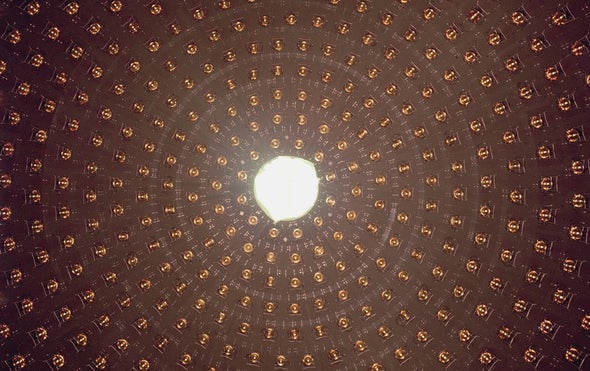by CLARA MOSKOWITZ
 The interior of the MiniBooNE detector is studded with photodetectors to capture the light signal created when a neutrino interacts. PHOTO/Fermilab/Los Alamos
The interior of the MiniBooNE detector is studded with photodetectors to capture the light signal created when a neutrino interacts. PHOTO/Fermilab/Los Alamos
“Sterile neutrinos” that ignore all other particles might be showing up in experiments—and could even help solve the mystery of dark matter
Physicists have caught ghostly particles called neutrinos misbehaving at an Illinois experiment, suggesting an extra species of neutrino exists. If borne out, the findings would be nothing short of revolutionary, introducing a new fundamental particle to the lexicon of physics that might even help explain the mystery of dark matter.
Undeterred by the fact that no one agrees on what the observations actually mean, experts gathered at a neutrino conference this week in Germany are already excitedly discussing these and other far-reaching implications.
Neutrinos are confusing to begin with. Formed long ago in the universe’s first moments and today in the hearts of stars and the cores of nuclear reactors, the miniscule particles travel at nearly the speed of light, and scarcely interact with anything else; billions pass harmlessly through your body each day, and a typical neutrino could traverse a layer of lead a light-year thick unscathed. Ever since their discovery in the mid–20th century, neutrinos were predicted to weigh nothing at all, but experiments in the 1990s showed they do have some mass—although physicists still do not know exactly how much. Stranger still, they come in three known varieties, or flavors—electron neutrinos, muon neutrinos and tau neutrinos—and, most bizarrely, can transform from one flavor to another. Because of these oddities and others, many physicists have been betting on neutrinos to open the door to the next frontier in physics.
Now some think the door has cracked ajar. The discovery comes from 15 years’ worth of data gathered by the Mini Booster Neutrino Experiment (MiniBooNE) at Fermi National Accelerator Laboratory in Batavia, Ill. MiniBooNE detects and characterizes neutrinos by the flashes of light they occasionally create when they strike atomic nuclei in a giant vat filled with 800 tons of pure mineral oil. Its design is similar to that of an earlier project, the Liquid Scintillator Neutrino Detector (LSND) at Los Alamos National Laboratory in New Mexico. In the 1990s LSND observed a curious anomaly, a greater-than-expected number of electron neutrinos in a beam of particles that started out as muon neutrinos; MiniBooNE has now seen the same thing, in a neutrino beam generated by one of Fermilab’s particle accelerators.
Because muon neutrinos could not have transformed directly into electron flavor over the short distance of the LSND experiment, theorists at the time proposed that some of the particles were oscillating into a fourth flavor—a “sterile neutrino”—and then turning into electron neutrinos, producing the mysterious excess. Although the possibility was tantalizing, many physicists assumed the findings were a fluke, caused by some mundane error particular to LSND. But now that MiniBooNE has observed the very same pattern, scientists are being forced to reckon with potentially more profound causes for the phenomenon. “Now you have to really say you have two experiments seeing the same physics effect, so there must be something fundamental going on,” says MiniBooNE co-spokesperson Richard Van de Water of Los Alamos. “People can’t ignore this anymore.”
The MiniBooNE team submitted its findings on May 30 to the preprint server arXiv, and is presenting them this week at the XXVIII International Conference on Neutrino Physics and Astrophysics in Heidelberg, Germany.
Scientific American for more